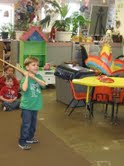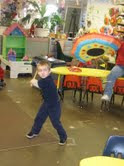
The bell rings. The children stand and listen. The teacher with the bell explains to the children that it is time to pick up their toys and put them away. It is at this point that a child’s character really shines or fails to shine. One of the things you can count on in early childhood are toys taken out and not put away by the person who took them out. So when that bell rings and the direction is “put your toys away” several personalities are going to show.
First, there is the model child who naturally puts his own toys away and is also willing to put every other child’s toys away as well. This is the caretaker child. This is the child who takes responsibility for himself and everyone around him. He doesn’t waste the teacher’s time by asking, “What would you like MEEEEEEEEEEEEEEEEEEE to do?” It’s not the first time the bell has rung; it’s not the first time toys have been put away; and most importantly he is not the only person in the room. It’s not time for discussion; it’s time for action, and the caretaker child knows what to do, how to do it, and if you asked him to think it through just a tiny bit, could probably tell you that if the toys are not put away, breakfast or lunch or class or whatever is coming next could not be accomplished.
Secondly, there is the dutiful child who puts his own toys away and quietly goes to his place on the carpet. This child goes by the book. He understands what his duty is and does it. He’s quiet and right on the mark. It wouldn’t occur to him to put any other child’s toys away, because his focus is on refining his own world – not some other child’s world. If you watched him, he would put just about half of what he and his friend were playing with away. If you asked him to help another child clean up, you would see the irritation rise in his face. He would do it because you asked, but he wouldn’t be cheerful about it, and he would never think to help another child on his own.
Thirdly, there is the shirker child. This child will run to the bathroom every time the bell rings, and he will hide in there until all the work is done. It’s never his mess; never his toy, and never his responsibility to pick up anything. After all, he didn’t get anything out; he didn’t play with anything; and even if he did, you couldn’t prove it – so there. The attitude is, “You rang the bell; do it yourself!”
Fourthly, there is the child who hears the bell and can’t wait to make order into chaos. Mr. Chaos will race through the playroom knocking toys out of everyone’s hands; roll in every pile made on the floor and generally reek havoc where order begs to be made. He is loud, disrespectful, and ultimately serving his own purpose.
And lastly, there is the child who hears the bell and ignores it – Mr. Selfo. “Not me, not now, not ever,” is his response to responsibility. “I’m special and you don’t understand; I don’t have to.” It’s the daily report.
On the job the same people play their parts – only adults are bigger and the responsibilities are greater. There is the caretaker personality – the person who takes charge because they can imagine the predictable outcome of the job failing. The caretaker would never ring the bell and then tell the children to pick up their toys and promptly leave the room because he or she has thought out the chaos that would ensue. The caretaker teacher knows that there are several personalities working here and all needing his or her care NOW.
The by the book teacher rings the bell and instructs the children and then promptly folds. He or she doesn’t leave the room, but he or she might as well. The ringing and instructing concludes the job for him or her. The idea that MORE than that must be done – keeping the personalities in check, making sure that the shirker stays to help, that Mr. Selfo contributes, and that Mr. Chaos is put in check is way way beyond what the book teacher is willing or able to do or even thinks to do and is actually amazed when another teacher suggests that – uh, the job isn’t done!
Then we have the shirker teacher. This teacher leaves the room every time a task must be accomplished. This teacher never rings the bell, because responsibility is calling…. This teacher is notorious for starting irrelevant conversations just as the bell rings simply to avoid work. This teacher is the last to volunteer, the last to speak up, and the last to take his or her turn at what everyone else has spent hours struggling with. It is simply not his responsibility. One almost wants to believe that this teacher believes the task or work is beneath him.
I’ve hired teachers in the past for very short periods of time who mirror the chaotic child. This teacher thrives on confusion and is determined to pull apart any day and any activity. And last but not least there is the teacher who is never quite sure what the bell was rung for and can’t ask because he or she didn’t think to ask and ultimately really doesn’t care a whole lot.
The human character is built in early childhood. It is during the first five years of life that parents teach children how to treat the world. If a parent is a caretaker, the child will most likely follow suit. Adults who take responsibility naturally teach responsibility – simply by doing. Caretaker children thrive on caring for their world and their neighbors’ world. These are the children who have a constant smile, who are always cheerful, and who are the greatest achievers in the classroom, the school and the community.
Adults who teach their children to do only a little and do it by the book will have children who do little and only by the book. These are neither the negative nor the positive classroom personalities. These are the kids who never really shine. They have an emotional limit for everything and a dead end before any great finale of life. The colors are dimmed.
And likewise with shirking and being chaos makers and ultimately being so special that nothing applies except the candy and the extras – especially at home.
Parents teach children by example. Children thrive on that example and the positive rewards that come from life’s successes. Some children really struggle to pull away from the limitations parents have put on them from infancy, and that’s a shame. These kids will never win kudos from their parents.
So the big question to ask is, “What personality do I have, and what personality do I want my children to have, and what am I willing to do or change or encourage to get that outcome?”
The big key to making changes or encouraging an already caretaking personality is to help the child look beyond the task at hand to the outcome and understand what it all means. Teaching a child to think his behavior through to the end of the activity is the name of the success game. “If I help Donnie clean up his blocks, we will all get to eat sooner.” A caretaking child always sees the bigger picture. He always understands the human condition, and he’s willing to take a chance to be that classroom mench. And as this child grows up, he becomes the delight of his parents. He’s the child who will win good sport awards, the leadership awards, the best friend awards.
Always encourage your child to take care of his world, to be involved, to let his limits soften, to look beyond what is to what will be and what could be. He will be the one who is constantly smiling.




